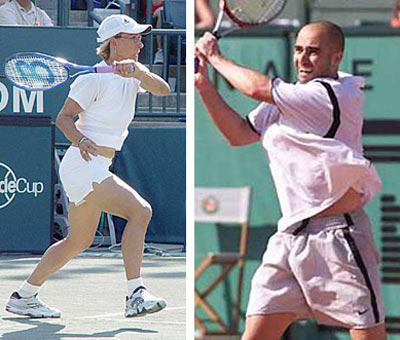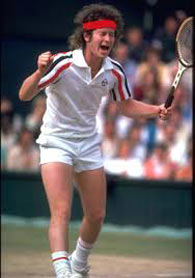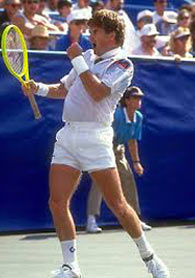|
TennisOne Lessons Let's Give Djokovic Some Love Paul Fein “It’s still the same old story. A fight for love and glory.” — from the song As Time Goes By Like an impassioned conductor galvanizing an orchestra, Novak Djokovic spread his arms toward the 2011 US Open crowd and smiled. He appealed for their appreciation after a brilliant, match-saving shot, and for their energy to sustain his improbable comeback. It worked. Spectators who had rooted wildly for five-time champion Roger Federer responded with a thunderous ovation for Djokovic.
On the brink of extinction—down 5-3, 40-15 in the fifth set—Djokovic had just blasted a forehand winner off Federer’s first serve. This was a repeat of his memorable Houdini-like escape against the legendary Federer in the 2010 US Open semifinals when he also staved off two match points with eye-popping winners. The crowd’s reaction this time was even more surprising than Djokovic’s feat. The Serb was inspired by boisterous New York fans who three years earlier had jeered him for criticizing American favorite Andy Roddick. This turnabout in loyalty was brief, though. For years Djokovic has always played third fiddle in the popularity stakes to shot-maker extraordinaire Federer and the hard-working, modest Rafael Nadal. Dethroning these giants on the court was another matter—Federer holds a record 17 major titles with Nadal tied for second at 14. In the most dominating season since Rod Laver’s 1969 Grand Slam, Djokovic came within a match of achieving the same rare feat this year, losing only the French Open final to Stan Wawrinka. He also captured a record six Masters titles and the ATP Finals. That gave Djokovic the No. 1 ranking for the fourth time in the past five years and boosted his majors’ total to 10. Spectacular success has won the admiration of fans, but not their love. In the ATP poll, the fans voted Federer their favorite player for a record 13th straight year. Djokovic came in third, behind Nadal. Federer is so universally beloved that Gilles Simon even expressed concern that French spectators would cheer for the Swiss superstar rather than French players in their 2014 Davis Cup final in Lille. Before the Djokovic-Federer final at the recent ATP Finals, ESPN analyst Brad Gilbert predicted 98 percent of the crowd would be with Federer when Gilbert gave him the highest grade in the “intangibles” category. “I think the fans have been unfair to Novak,” empathized Martina Navratilova. “He’s been the ultimate pro—both when he’s won and when he’s lost.” Indeed, he has. But first impressions can last a long time, and fans remember the young Djokovic for often retiring during matches with injuries and illnesses and for brash remarks about overtaking their two heroes. His mother Dijana added to the unattractive image when she infamously and prematurely declared, “The king is dead” after Novak upset Federer in the 2008 Australian Open semifinals.
You also may recall the “Image is everything” camera commercial that haunted Andre Agassi early in his roller-coaster career. “This ubiquitous slogan, and the wave of hostility and criticism and sarcasm it sets off, is excruciating,” Agassi confided in his tell-all memoir, OPEN. He was reviled as all glamour and glitz and no guts or major titles. Finally, in his 30s, the much-evolved Agassi became revered as a beloved, elder statesman. Like Agassi, 1970s−1980s superstar Navratilova suffered from a bad image for years before being accepted and eventually embraced. In a much-less accepting era, many fans were turned off by her being a lesbian, a Communist defector, or a muscle-bound freak and never warmed to the athletic ex-Czech despite her entertaining, serve-volley game. In stark contrast, longtime archrival Chrissie Evert, the feminine-looking, girl-next-door American, became the crowd darling. Pete Sampras, another under-appreciated superstar, said he was always baffled when the media called him “boring.” That misperception prompted me to write a paean, “22 Reasons to Love Pete Sampras” (http://tennisconfidential.com/22_reasons_to_love_Pete_Sampras.php) to set the record straight. Some reputations, though, are well-deserved: Jimmy Connors for his early-career vulgarity; and Ivan Lendl for his on-court dourness and locker-room nastiness that were memorialized by a 1987 Sports Illustrated cover story titled “The Champion Nobody Cares About.” And let’s not forget John McEnroe, notorious for his temper tantrums. During the 1979 US Open, winner McEnroe and runner-up Vitas Gerulaitis, who was liked by fellow players and loved by the ladies, got neither from their own hometown sports fans. “They hate us,” Gerulaitis quipped. “Popularity-wise, I’m a notch above John, and John is a notch above [New York mass murderer] Son of Sam.”
But what’s not to like, even love, about Djokovic? His picture-perfect strokes, especially his incomparable backhand, are a delight to watch and most appreciated by tennis connoisseurs. “While Federer’s shots are often spectacular, Djokovic plays spectacular tennis in a very unspectacular way,” former world No. 4 Gene Mayer points out. Equally impressive, Djokovic is unfailingly gracious in defeat as well as in victory. After his heartbreaking French Open loss, he said, “It’s not easy for me to speak right now, but I have to say that in life some things are more important than victories, and those are character and respect. I have great respect for you Stan.” Djokovic considers his marriage to his longtime love Jelena and fatherhood to one-year-old Stefan even more important than his self-described “perfectionist” and “holistic” quest to be the best.
In 2012 Djokovic received the Arthur Ashe Humanitarian of the Year award for his eponymous foundation (which helps underprivileged kids around the world) and UNICEF ambassador work. The handsome 28-year-old extrovert is genial to the media, tournament staffers, and fans. And, though he no longer does funny impersonations of other players—how he earned his nickname “Djoker”—his sense of humor and quick wit are also appealing. One of the “Hints to Spectators” in the 1928 Wimbledon official announcement was this gem: “Please do not confine your applause to one competitor, give the other his or her due.” It’s quaint but also timeless advice. Djokovic has already earned enough glory to last a lifetime. Now all he needs is some love. * * * * * Your comments are welcome. Let us know what you think about Paul Fein's article by emailing us here at TennisOne.
Paul Fein Paul Fein has received more than 30 writing awards and authored three books, Tennis Confidential: Today’s Greatest Players, Matches, and Controversies, You Can Quote Me on That: Greatest Tennis Quips, Insights, and Zingers, and Tennis Confidential II: More of Today’s Greatest Players, Matches, and Controversies. Fein is also a USPTA-certified teaching pro and coach with a Pro-1 rating, former director of the Springfield (Mass.) Satellite Tournament, a former top 10-ranked men’s open New England tournament player, and currently a No. 1-ranked Super Senior player in New England. |



